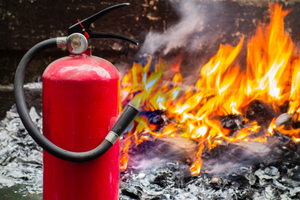Even a small fire may spread rapidly if you do not know how to put it out and what to use to extinguish it. There are different types of fires and dedicated fire extinguishing products corresponding to each fire group. What should you know about them? Here is a handful of the key facts.

What is a fire and what happens if you extinguish it the wrong way?
The term ‘fire’ stands for an uncontrolled combustion process that occurs in an area other than assigned zones such as fireplaces or hearths. Combustion is the reaction of a combustible liquid, solid or gaseous material with an oxidiser (air). The reaction is accompanied by the emission of light and thermal energy.
Every material burns in a specific manner. It is essential to choose the right method to eliminate fire. If you use a wrong fire extinguishing product, it may have fatal consequences. Fire spreads fast and poisonous gases enter the atmosphere. What adds to the destruction is the extremely high, deadly temperature that’s unbearable for people, animals and plants all.
Fire groups and extinguishing products
For answers to the questions: what are the types of fires and methods of extinguishing fires? See for example the Polish standard PN-EN 2:1998/A1:2006 and the Ordinance of the Minister of Internal Affairs and Administration of 7 June 2010. The two documents contain a classification of 5 fire groups defined according to the type of the material that is burning; they are as follows:
- A: fires of solid (mostly organic) materials, including wood and textiles,
- B: fires of liquid or meltable substances, for example: plastics or petroleum;
- C: fires of gases;
- D: fires of metals;
- F: fires of kitchen oils and greases (this is the most recent category identified in the updated standard PN-EN 2:1998/A1:2006).
Specific fire extinguishing products are assigned to each fire group mentioned.
What fire extinguishing products are available?
As humans discovered fire, they also started to look intuitively for different method to control it or put it out. The oldest extinguishing products include water and sand. At present, we have many more methods of fire extinguishment. Manufacturers in the fire protection industry keep developing new solutions and technologies that make it possible to eliminate fire in a safe manner.
The whole range of marketed fire extinguishing products could be classified in 3 groups:
- water (including aerosols and foams),
- fire-extinguishing gases (incombustible neutral gases and halons) and
- fire-extinguishing powders.

What should guide our selection of fire-extinguishing products?
Knowledge on the types and applications of fire-extinguishing products could save your life and property. Not every fire may be extinguished with water and not every type of fire extinguisher is suitable for fighting any and all sources of fire. When selecting fire-extinguishing products, it is advisable to talk to an OHS expert or a supplier of fire-fighting equipment and articles. We also recommend reading a brochure: Gaszenie pożarów oraz środki gaśnicze (Fire-fighting and extinguishing products) at Serwis Rzeczypospolitej Polskiej (The Website of the Republic of Poland), to learn more about fire protection. This brief reference material is available online and contains a lot of crucial and practical information, including hints on the selection of fire-extinguishing products according to the type of fire.
Important: every chemical mixture used in the production of extinguishing products should have a certificate (of admittance) from CNBOP (the Scientific and Research Centre for Fire Protection) confirming its fitness and quality.
What should we use to extinguish a fire of gases?
Uncontrolled ignitions of gases are some of the most problematic types of fires. What should they be extinguished with? Use powder fire extinguishers for this purpose. If such a fire occurs at a paint shop or gas cylinder storage, you should preferably activate a fire-extinguishing system that would smother the fire with carbon dioxide. At state-of-the-art industrial plants, such a system is enabled automatically when a fire is detected.
Another solution and method for extinguishing fires of gases is to use green halon fire extinguishers that contain gas FE-36, a derivative of propane, instead of ozone. An alternative for halons is provided by hand-held carbon-dioxide extinguishers that discharge liquefied carbon dioxide.

Fires of solids – fire-extinguishing products
And what should you use to put out burning municipal waste, clothing or hay? To extinguish a fire of solids, it is best to use:
- water (not applicable to fires of electrical systems!),
- a foam or dry-powder extinguisher,
- carbon dioxide,
- sand or
- a fire blanket (for a small fire that is not spreading rapidly).
Extinguishing of fires of liquids and meltable substances
Flammable liquids such as petrol, petroleum or acetone and meltable substances (adhesives, paraffin wax) should be extinguished with type B foam extinguishers. The foam obtained through the combination of water and a foaming agent cools down heated liquids and cuts off oxygen. Dedicated OHS warehouses and stores provide different types of fire-extinguishing products for class B fires – they vary in their volume, the type and content of the foaming agent as well as foam density.
The production of fire-extinguishing products is a vital industry partly responsible for our safety. If you look for the right raw materials for the production of fire-extinguishing products, opt for the tried and tested manufacturers that offer high quality substances. For a specialist range dedicated to fire-extinguishing products, see the PCC Group’s Product Portal. Learn more details!
